Related Research Articles

The kea is a species of large parrot in the family Nestoridae found in the forested and alpine regions of the South Island of New Zealand. About 48 cm (19 in) long, it is mostly olive-green with a brilliant orange under its wings and has a large, narrow, curved, grey-brown upper beak. Its omnivorous diet includes carrion, but consists mainly of roots, leaves, berries, nectar, and insects. Now uncommon, the kea was once killed for bounty due to concerns by the sheep-farming community that it attacked livestock, especially sheep. In 1986, it received absolute protection under the Wildlife Act.
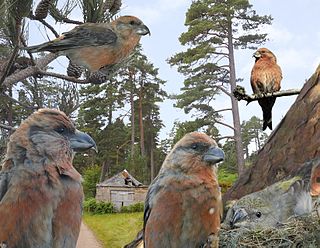
The Scottish crossbill is a small passerine bird in the finch family Fringillidae. It is endemic to the Caledonian Forests of Scotland, and is the only terrestrial vertebrate species endemic to the United Kingdom. The Scottish crossbill was confirmed as a unique species in August 2006, on the basis of having a distinctive bird song.

Spix's macaw, also known as the little blue macaw, is a macaw species that was endemic to Brazil. It is a member of tribe Arini in the subfamily Arinae, part of the family Psittacidae. It was first described by German naturalist Georg Marcgrave, when he was working in the State of Pernambuco, Brazil in 1638 and it is named for German naturalist Johann Baptist von Spix, who collected a specimen in 1819 on the bank of the Rio São Francisco in northeast Bahia in Brazil. This bird has been completely extirpated from its natural range, and following a several-year survey, the IUCN officially declared it extinct in the wild in 2019.
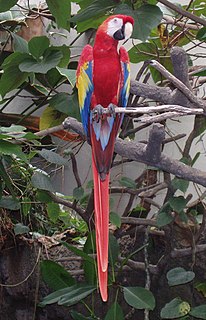
The scarlet macaw is a large red, yellow, and blue Central and South American parrot, a member of a large group of Neotropical parrots called macaws. It is native to humid evergreen forests of the Neotropics. Its range extends from south-eastern Mexico to Peru, Ecuador, Colombia, Bolivia, Venezuela and Brazil in lowlands of 500 m (1,600 ft) up to 1,000 m (3,300 ft), the Caribbean island of Trinidad, as well as the Pacific island of Coiba. Formerly, it ranged north to southern Tamaulipas. In some areas, it has suffered local extinction because of habitat destruction, or capture for the parrot trade, but in other areas, it remains fairly common. It is the national bird of Honduras. Like its relative the blue-and-yellow macaw, the scarlet macaw is a popular bird in aviculture as a result of its striking plumage.

The New Zealand kākā is a large species of parrot of the family Nestoridae found in New Zealand's native forests. The species is often known by the abbreviated name kākā, although it shares this name with the recently extinct Norfolk kākā and Chatham kākā. Two subspecies of New Zealand kākā are recognised. It is endangered and has disappeared from much of its former range, though recent conservation efforts mean the birds are increasingly common across Wellington.
The night parrot is a small parrot endemic to the continent of Australia. It has also been known as porcupine parrot, nocturnal ground parakeet, midnight cockatoo, solitaire, spinifex parrot and night parakeet. It is one of the most elusive and mysterious birds in the world, with no confirmed sightings of the bird between 1912 and 1979, leading to speculation that it was extinct. Sightings since 1979 have been extremely rare and the bird's population size is unknown, though based on the paucity of records it is thought to number between 50 and 249 mature individuals, and it is classified by the IUCN as an endangered species.

The orange-bellied parrot is a small parrot endemic to southern Australia, and one of only three species of parrot that migrate. It was described by John Latham in 1790. A small parrot around 20 cm (8 in) long, it exhibits sexual dimorphism. The adult male is distinguished by its bright grass-green upper parts, yellow underparts and orange belly patch. The adult female and juvenile are duller green in colour. All birds have a prominent two-toned blue frontal band and blue outer wing feathers.
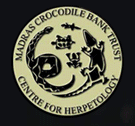
The Madras Crocodile Bank Trust and Centre for Herpetology (MCBT) is a reptile zoo and herpetology research station, located 40 kilometres (25 mi) south of the city of Chennai, in state of Tamil Nadu, India. The centre is both a registered trust and a recognized zoo under the Wildlife (Protection) Act, 1972 and comes under the purview of the Central Zoo Authority, Ministry of Environment and Forests, Government of India. It was established with the aim of saving three Indian endangered species of crocodile—the marsh or mugger crocodile, the saltwater crocodile, and the gharial, which at the time of founding of the trust were all nearing extinction.

The yellow-shouldered amazon, also known as the yellow-shouldered parrot, is a parrot of the genus Amazona that is found in the arid areas of northern Venezuela, the Venezuelan islands of Margarita and La Blanquilla, and the island of Bonaire. It has been extirpated from Aruba and introduced to Curaçao.

Loro Parque or 'Loro Park' is a 13.5-hectare (33-acre) zoo on the outskirts of Puerto de la Cruz on Tenerife, Spain where it houses an extensive and diverse reserve of animal and plant species. The park was conceived as a paradise for parrots and has developed over the years into one of the biggest attractions of the Canary Islands, with over 40 million visitors. The park keeps orcas, which has attracted criticism from some organisations.
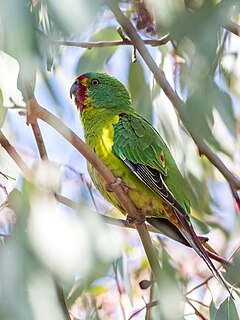
The swift parrot is a species of broad-tailed parrot, found only in southeastern Australia. The species breeds in Tasmania during the summer and migrates north to south eastern mainland Australia from Griffith-Warialda in New South Wales and west to Adelaide in the winter. It is a nomadic migrant, and it settles in an area only when there is food available.

The Saint Vincent amazon also known as Saint Vincent parrot, is a large, approximately 40 cm long, multi-colored amazon parrot with a yellowish white, blue and green head, greenish-bronze upperparts plumage, and violet blue-green wings.
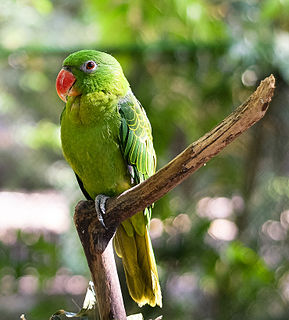
The blue-backed parrot, also known as Müller's parrot is a large, endangered species of parrot endemic to the Philippines. It is found in tropical moist lowland forests. Flocks are small and often active at night. Its main threats are habitat loss and trapping for the pet trade.
The Zoo and Aquarium Association Australasia (ZAA), based in Sydney, Australia and Wellington, New Zealand, is an association of zoos, aquariums, sanctuaries and wildlife parks across Australia, New Zealand, Papua New Guinea and the South Pacific Islands, whose central goal is to support and verify animal welfare among its members and in the wild.

Parrots, also known as psittacines, are birds of the roughly 398 species in 92 genera comprising the order Psittaciformes, found mostly in tropical and subtropical regions. The order is subdivided into three superfamilies: the Psittacoidea, the Cacatuoidea (cockatoos), and the Strigopoidea. One-third of all parrot species are threatened by extinction, with higher aggregate extinction risk than any other comparable bird group. Parrots have a generally pantropical distribution with several species inhabiting temperate regions in the Southern Hemisphere, as well. The greatest diversity of parrots is in South America and Australasia.
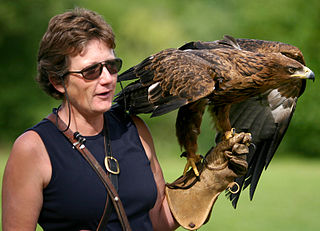
Jemima Parry-Jones is a British authority on birds of prey (raptors), a conservationist, author, raptor breeder, lecturer, consultant and is the Director of the International Centre for Birds of Prey.

Paradise Park is a wildlife sanctuary situated in Hayle, Cornwall, England. It has over 1000 birds and animals and is the home of the World Parrot Trust.
Carl Gwynfe Jones, MBE is a Welsh conservation biologist, who has been employed by Durrell Wildlife Conservation Trust since 1985, and a founding member (1984) and current scientific director of Mauritian Wildlife Foundation (MWF). Additionally he is Chief Scientist at Durrell Wildlife Conservation Trust, and an honorary professor in ecology and conservation biology at the University of East Anglia. Often outspoken on the importance of knowing your species and using intuition, empathy and practical knowledge over dogmatic education, Jones is best known for his work in recovering the Mauritius kestrel from just four individuals in 1974, to an estimated 400. Working in the Mascarene Islands since 1979, Jones has led five successful bird restoration projects where the starting population has numbered less than 12 individuals; as a consequence Mauritius has averted more bird extinctions than any other country. Jones has pioneered the use of ecological or taxon replacements to fill the ecological roles of extinct animals and successfully restored levels of endemic vegetation to previously denuded islets. Jones' work has been highlighted in Douglas Adams and Mark Carwardine's 1990 radio documentary Last Chance to See, along with its accompanying book, as well as David Quammen's 1996 book The Song of the Dodo: Island Biogeography in an Age of Extinctions.

The grey parrot, also known as the Congo grey parrot, Congo African grey parrot or African grey parrot, is an Old World parrot in the family Psittacidae. The Timneh parrot (Psittacus timneh) once was identified as a subspecies of the grey parrot, but has since been elevated to a full species.
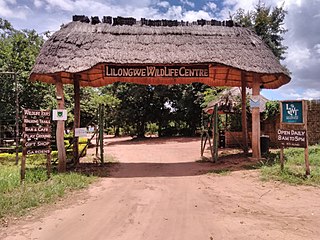
The Lilongwe Wildlife Centre is a wildlife sanctuary in Lilongwe, Malawi. It was founded in 2007 by the Lilongwe Wildlife Trust (LWT), with support from the Born Free Foundation. The Centre is a member of the Pan African Sanctuary Alliance.
References
- ↑ "How did the World Parrot Trust start?". World Parrot Trust. Retrieved 14 March 2021.
- ↑ "Our Work" . Retrieved 11 August 2007.
- ↑ "Action plan launched to save endangered parrots" . Retrieved 11 August 2007.